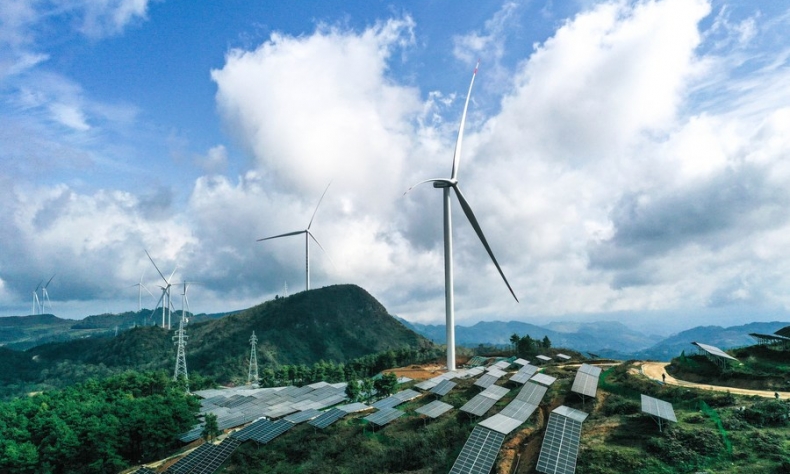Rising to the Challenge

China has immense potential in developing a green economy due to its strong government commitment, vast market size, and technological capabilities.
Opportunities for green development cooperation between China and the United States are opening up as the countries on January 12 launched their Working Group on Enhancing Climate Action, as agreed in the Sunnylands Statement on Enhancing Cooperation to Address the Climate Crisis released last November. In an exclusive interview with Beijing Review reporter Zhang Shasha, Michael Hart, President of the American Chamber of Commerce in China (AmCham China), shared his views on China’s green development, the respective advantages of Chinese and U.S. enterprises in shaping a sustainable future, and the possibilities for collaboration between the two sides. Edited excerpts from their conversation follow:
Beijing Review: What notable changes have you seen in China’s approach to green development over the past few decades?
Michael Hart: A significant shift in China’s approach to green development has been observed. The country is still one of the world’s largest consumers of coal and fossil fuels, but has made solid progress in embracing renewable energy sources and reducing its reliance on fossil fuels.
China has become the world’s largest investor in renewable energy, with substantial investments in solar, wind and hydroelectric power. This transition has not only helped China create a path to reduce its carbon emissions but has also positioned the country as a global leader in clean energy technology.
Can you highlight specific areas of development that made a lasting impression on you?
One area is the country’s commitment to renewable energy. China has made significant investments in solar and wind power, becoming the world’s largest producer and consumer of renewable energy. The scale and speed at which China has developed its renewable energy sector is impressive. In addition to a path to reduce carbon emissions, this commitment also creates new job opportunities and new drivers of economic growth.
How do AmCham China member companies view cooperation with stakeholders in China to promote sustainability?
They highly value this type of cooperation. They recognize the importance of working together with government agencies, environmental organizations and local communities to achieve sustainable and environment-friendly business practices. This collaboration not only helps protect the environment, but also enhances the reputation and competitiveness of American businesses in China.
In particular, AmCham China companies have contributed significantly to U.S.-China climate cooperation. Examples include collaborative initiatives aimed at reducing carbon emissions and promoting sustainable practices. A large majority of our members place great emphasis on Environmental, Social, and Governance (ESG) strategies in their China operations. (ESG is a management and analytical framework for understanding and measuring how sustainably an organization operates.)

What are the respective advantages of Chinese and U.S. companies in green transition?
Chinese companies have a significant advantage in this aspect due to their scale and government support. With a large domestic market and access to abundant resources, they have the capacity to invest in and implement large-scale green projects. Additionally, the Chinese Government has implemented policies and incentives to promote green development, providing support and guidance to companies in this sector.
Unfortunately, we do find instances in various industries where domestic companies are given preferential treatment and/or market access is closed to foreign companies, so we would urge the government to ensure that the playing field is level—especially in areas of global importance, such as green development.
U.S. companies excel in green development through their technological innovation and market expertise.
The U.S. has a strong tradition of research and development, leading to the creation of cutting-edge technologies in renewable energy, sustainable materials, and environmental solutions. These U.S. companies also have a deep understanding of global markets and consumer preferences, allowing them to effectively commercialize and distribute green products and services worldwide.
Importantly, a wide range of U.S. companies have made their own commitments to reducing their own carbon emissions and tracking their progress very publicly. We are proud to see many U.S. companies leading by example.
How important is cooperation between Chinese and U.S. companies in the area of green and low-carbon initiatives?
U.S.-China cooperation holds immense significance in addressing the global climate crisis. By joining forces, these two economic powerhouses have the potential to leverage their respective strengths and resources to develop innovative solutions, accelerate the adoption of clean technologies, and drive sustainable development on a larger scale.
Cooperation between Chinese and U.S. companies in green and low-carbon initiatives not only promotes environmental sustainability but also creates new business opportunities and economic growth.

By collaborating on clean energy projects, carbon reduction strategies, and sustainable practices, both countries can benefit from the creation of green jobs, increased investment, and enhanced competitiveness in the global market.
It is notable that when the U.S. and China met on the sidelines of the APEC Economic Leaders’ Meeting in San Francisco, California, last November, the environmental meetings were some of the most in-depth ever held and we hope that cooperation on this topic can be a real area of success for the two countries.
What is your assessment of China’s potential to develop a green economy?
China has immense potential in developing a green economy due to its strong government commitment, vast market size, and technological capabilities.
The Chinese Government has set ambitious targets for national carbon peaking and neutrality, to be achieved before 2030 and 2060, respectively, and renewable energy adoption, creating a favorable policy environment for green investments.
With its large population, growing middle class and mounting awareness of environmental issues, China offers a significant market for green products and services. U.S. companies have much to offer in this area.
China’s potential in developing a green economy extends beyond its domestic market. As the world’s largest emitter of greenhouse gases, China’s efforts in transitioning to a green economy can have a significant impact on global climate change mitigation.
By investing in renewable energy, energy efficiency and sustainable infrastructure, China can not only reduce its carbon footprint but also contribute to global efforts in achieving the goal of the 2015 Paris Agreement [to keep the rise in global average temperature well below 2 degrees Celsius above pre-industrial levels and, if possible, below 1.5 degrees Celsius].
Additionally, China’s expertise in green technologies and its willingness to collaborate with international partners create opportunities for global cooperation and knowledge sharing in the pursuit of a sustainable future.
 Facebook
Facebook
 Twitter
Twitter
 Linkedin
Linkedin
 Google +
Google +










